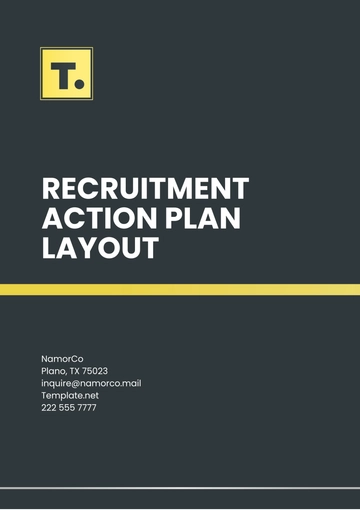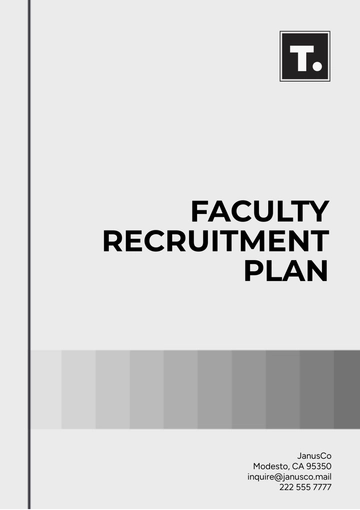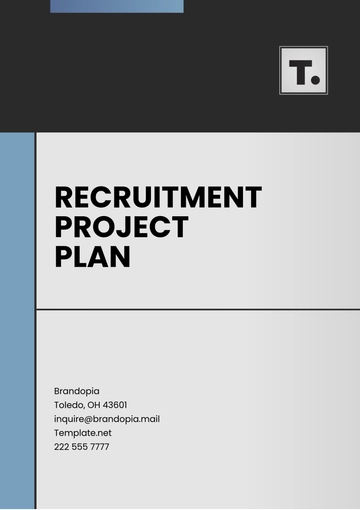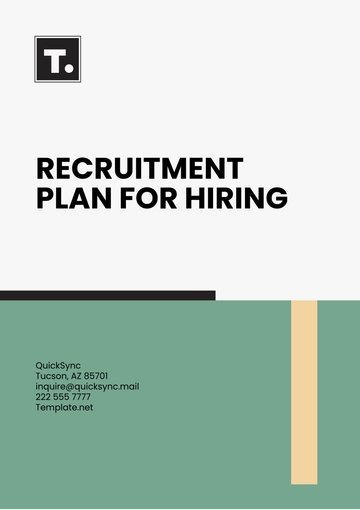Free Nurses Recruitment Plan

Prepared by: [YOUR NAME]
Company: [YOUR COMPANY NAME]
Department: [DEPARTMENT]
Date: [DATE]
I. Objective
The primary objective is to attract, recruit, and retain qualified nurses in order to adequately meet the staffing needs of [Your Company Name]. This endeavor is crucial to ensuring the delivery of high-quality patient care, which in turn leads to positive healthcare outcomes.
II. Current Needs Assessment
Review Staffing Levels: Analyze current staffing levels, turnover rates, and vacancy data to assess gaps and determine the exact number of nurses needed in each specialty.
Project Future Needs: Forecast the number of additional nursing staff required over the next 1-3 years, considering anticipated retirements, growth, and other organizational changes.
Skill and Experience Requirements: Identify the specific skills, certifications, and experience required for each position (e.g., ICU, Emergency Department, Pediatric, etc.).
III. Target Audience Identification
New Graduates: Collaborate with nursing schools to attract recent graduates with a passion for learning and development.
Experienced Nurses: Focus on attracting nurses with at least 2-5 years of experience in high-demand areas to address gaps requiring specific expertise.
Nurse Practitioners and Specialized Roles: Identify specific strategies for recruiting nurse practitioners and specialized nursing roles such as Certified Registered Nurse Anesthetists (CRNAs) and Clinical Nurse Specialists (CNSs).
IV. Employer Branding
Highlight Unique Benefits: Emphasize factors such as competitive salaries, comprehensive benefits, career advancement opportunities, continuing education programs, and a supportive work environment.
Develop Recruitment Materials: Create compelling digital and print materials highlighting testimonials, career pathways, employee satisfaction, and community involvement.
Use Social Media and Digital Marketing: Actively promote the organization’s brand and culture on social media platforms like LinkedIn, Instagram, and Facebook. Consider paid ads to reach a broader nursing audience.
V. Outreach and Partnerships
Partner with Nursing Schools: Establish or strengthen partnerships with local and national nursing schools for clinical rotations, internships, and job fairs.
Engage Professional Organizations: Collaborate with professional nursing associations such as the American Nurses Association (ANA) and state nursing associations to access their membership networks.
Join Career Fairs and Conferences: Participate in virtual and in-person career fairs, nursing conferences, and healthcare expos to increase visibility and connect with potential candidates.
VI. Recruitment Channels
Job Boards: Post vacancies on popular nursing job boards (e.g., Nurse.com, Indeed, Glassdoor) and healthcare-focused platforms like Health eCareers.
Social Media and Referrals: Encourage current employees to refer qualified candidates and reward successful referrals. Actively share job postings on social media platforms with high engagement.
Internal Career Website: Ensure that all nursing roles are easily accessible on the organization’s career portal, optimized for mobile and user-friendly.
VII. Selection and Hiring Process
Screening and Interviewing: Standardize the screening process for nursing applicants to ensure a fair and efficient hiring experience. Schedule interviews with relevant nursing leadership and HR representatives.
Competency Assessments: Include assessments to evaluate clinical skills, situational judgment, and interpersonal skills. For specialized roles, incorporate testing specific to each specialty.
Offer and Onboarding: Once a candidate is selected, provide a competitive offer with clear benefits and career development opportunities. Follow up with a streamlined, supportive onboarding process focused on job training, facility orientation, and peer mentoring.
VIII. Retention Strategies
Professional Development and Career Pathways: Offer a clear path for career advancement, including continuing education, certifications, and internal training programs.
Work-Life Balance and Well-being: Implement flexible scheduling, wellness programs, mental health support, and resources for burnout prevention.
Engagement and Recognition Programs: Foster a culture of appreciation with regular recognition for achievements, service anniversaries, and employee contributions to patient care.
IX. Diversity and Inclusion
Diverse Recruitment Efforts: Target diverse nursing groups through partnerships with minority nursing associations and community programs to ensure a workforce reflective of the patient population.
Bias-Free Hiring Practices: Train HR and nursing leaders on inclusive hiring practices, including cultural competency and avoiding unconscious bias during interviews and assessments.
X. Evaluation and Continuous Improvement
Monitor Recruitment Metrics: Track metrics such as time-to-fill, cost-per-hire, turnover rates, and new-hire retention rates to gauge the effectiveness of recruitment efforts.
Solicit Feedback: Collect feedback from new hires and hiring managers to understand the candidate experience and identify areas for improvement.
Adjust Strategy as Needed: Regularly review the recruitment strategy and adjust it to respond to changes in nursing labor market trends, facility needs, and healthcare industry standards.
- 100% Customizable, free editor
- Access 1 Million+ Templates, photo’s & graphics
- Download or share as a template
- Click and replace photos, graphics, text, backgrounds
- Resize, crop, AI write & more
- Access advanced editor
Discover the ultimate solution for nursing recruitment with Template.net's Nurses Recruitment Plan Template. Crafted for efficiency, this editable and customizable template streamlines your hiring process. Tailor it to your institution's unique needs effortlessly with our Ai Editor Tool. Elevate your recruitment strategy today with this comprehensive resource from Template.net.
You may also like
- Finance Plan
- Construction Plan
- Sales Plan
- Development Plan
- Career Plan
- Budget Plan
- HR Plan
- Education Plan
- Transition Plan
- Work Plan
- Training Plan
- Communication Plan
- Operation Plan
- Health And Safety Plan
- Strategy Plan
- Professional Development Plan
- Advertising Plan
- Risk Management Plan
- Restaurant Plan
- School Plan
- Nursing Home Patient Care Plan
- Nursing Care Plan
- Plan Event
- Startup Plan
- Social Media Plan
- Staffing Plan
- Annual Plan
- Content Plan
- Payment Plan
- Implementation Plan
- Hotel Plan
- Workout Plan
- Accounting Plan
- Campaign Plan
- Essay Plan
- 30 60 90 Day Plan
- Research Plan
- Recruitment Plan
- 90 Day Plan
- Quarterly Plan
- Emergency Plan
- 5 Year Plan
- Gym Plan
- Personal Plan
- IT and Software Plan
- Treatment Plan
- Real Estate Plan
- Law Firm Plan
- Healthcare Plan
- Improvement Plan
- Media Plan
- 5 Year Business Plan
- Learning Plan
- Marketing Campaign Plan
- Travel Agency Plan
- Cleaning Services Plan
- Interior Design Plan
- Performance Plan
- PR Plan
- Birth Plan
- Life Plan
- SEO Plan
- Disaster Recovery Plan
- Continuity Plan
- Launch Plan
- Legal Plan
- Behavior Plan
- Performance Improvement Plan
- Salon Plan
- Security Plan
- Security Management Plan
- Employee Development Plan
- Quality Plan
- Service Improvement Plan
- Growth Plan
- Incident Response Plan
- Basketball Plan
- Emergency Action Plan
- Product Launch Plan
- Spa Plan
- Employee Training Plan
- Data Analysis Plan
- Employee Action Plan
- Territory Plan
- Audit Plan
- Classroom Plan
- Activity Plan
- Parenting Plan
- Care Plan
- Project Execution Plan
- Exercise Plan
- Internship Plan
- Software Development Plan
- Continuous Improvement Plan
- Leave Plan
- 90 Day Sales Plan
- Advertising Agency Plan
- Employee Transition Plan
- Smart Action Plan
- Workplace Safety Plan
- Behavior Change Plan
- Contingency Plan
- Continuity of Operations Plan
- Health Plan
- Quality Control Plan
- Self Plan
- Sports Development Plan
- Change Management Plan
- Ecommerce Plan
- Personal Financial Plan
- Process Improvement Plan
- 30-60-90 Day Sales Plan
- Crisis Management Plan
- Engagement Plan
- Execution Plan
- Pandemic Plan
- Quality Assurance Plan
- Service Continuity Plan
- Agile Project Plan
- Fundraising Plan
- Job Transition Plan
- Asset Maintenance Plan
- Maintenance Plan
- Software Test Plan
- Staff Training and Development Plan
- 3 Year Plan
- Brand Activation Plan
- Release Plan
- Resource Plan
- Risk Mitigation Plan
- Teacher Plan
- 30 60 90 Day Plan for New Manager
- Food Safety Plan
- Food Truck Plan
- Hiring Plan
- Quality Management Plan
- Wellness Plan
- Behavior Intervention Plan
- Bonus Plan
- Investment Plan
- Maternity Leave Plan
- Pandemic Response Plan
- Succession Planning
- Coaching Plan
- Configuration Management Plan
- Remote Work Plan
- Self Care Plan
- Teaching Plan
- 100-Day Plan
- HACCP Plan
- Student Plan
- Sustainability Plan
- 30 60 90 Day Plan for Interview
- Access Plan
- Site Specific Safety Plan





























